Sailing Across the Seas: How Many Miles Can a Sailboat Travel in a Day?
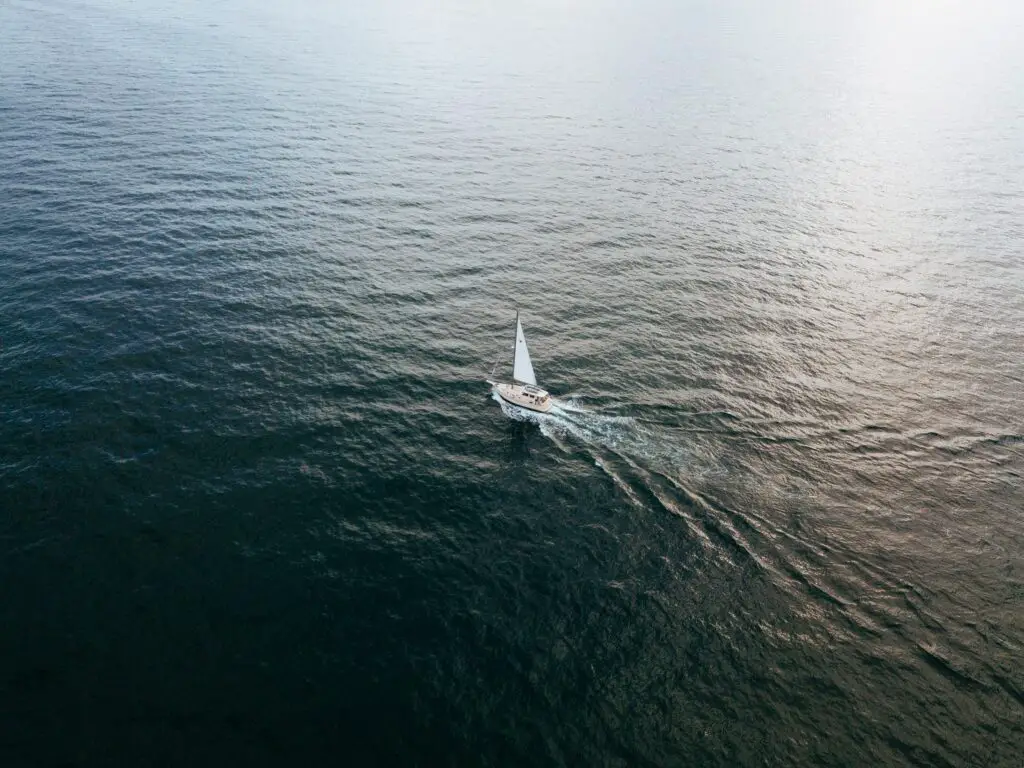
Sailing across the seas has been a dream of adventurers, explorers, and sailors for centuries. There is something undeniably alluring about the idea of setting out into the open water, propelled by the wind, and leaving the cares of the world behind. For many sailors, the question of how many miles can a sailboat travel in a day is both practical and romantic.
The distance a sailboat can cover in a day depends on many factors, including wind speed and direction, sea state and currents, the type of sailboat and its capabilities, and the skill and experience of the crew. While there are no hard and fast rules for calculating a sailboat’s daily distance, understanding these factors can help sailors make informed decisions about trip planning, sail selection, and navigation.
In this article, we will explore the question of how many miles a sailboat can travel in a day. We will look at the factors that affect a sailboat’s daily distance, discuss methods for calculating it, and explore the limits of a sailboat’s speed and range. We will also offer tips and tricks for maximizing the distance you can cover in a day and provide insights for aspiring sailors who want to set out on their own adventure.
Understanding the Factors
To understand how many miles a sailboat can travel in a day, it’s important to consider the various factors that can affect a sailboat’s daily distance. These include wind speed and direction, sea state and currents, the type of sailboat and its capabilities, and the skill and experience of the crew.
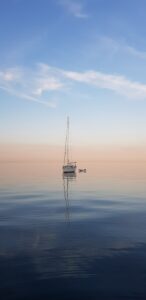
Wind speed and direction are perhaps the most critical factors in determining how far a sailboat can travel in a day. Sailboats are powered by the wind, and the speed and direction of the wind can make a significant difference in how fast a sailboat can go. A sailboat can typically sail at a speed equal to the true wind speed. The wind direction can also affect a sailboat’s speed, as sailing against the wind (called “beating” or “tacking”) is slower than sailing with the wind (called “running” or “reaching”).
Sea state and currents can also play a role in a sailboat’s daily distance. The state of the sea can affect the speed and stability of a sailboat, especially in rough or choppy conditions. Currents can also affect a sailboat’s speed and direction, and sailors must take them into account when plotting their course.
The type of sailboat and its capabilities are also important factors in determining how many miles a sailboat can travel in a day. Different types of sailboats have different speeds and capabilities, and sailors must consider these when planning their trips. For example, a small dinghy will typically sail at a slower speed than a larger yacht, and a sailboat designed for racing will be faster than one designed for cruising.
Finally, the skill and experience of the crew can make a significant difference in a sailboat’s daily distance. Experienced sailors are better equipped to handle changing conditions, adjust the sail plan for maximum speed, and navigate effectively. Novice sailors may need to learn these skills before attempting longer trips.
In the next section, we will discuss methods for calculating a sailboat’s daily distance, taking these factors into account.
Calculating a Sailboat’s Daily Distance
Calculating how many miles a sailboat can travel in a day can be a complex process, as it involves taking into account a variety of factors. However, there are several methods that sailors can use to estimate their daily distance.
One of the most common ways to measure a sailboat’s speed is with a knotmeter, which measures the speed of the boat through the water. The knotmeter gives the speed in knots, which is equivalent to nautical miles per hour. However, this measurement only gives the speed of the boat relative to the water, and not the distance traveled over ground.
To estimate the distance traveled over ground, sailors must adjust for leeway and current. Leeway is the sideways drift of the sailboat caused by the wind, while current is the movement of water caused by tides, waves, and other factors. These factors can cause a sailboat to travel a shorter or longer distance over ground than through the water, depending on the direction of the wind and current.
Sailors can estimate their distance traveled over ground by using a GPS device. GPS can provide accurate speed and position information, which can be used to calculate the distance traveled. Sailors can also use navigation tools such as charts and compasses to plot their course and estimate their distance.
It’s worth noting that the daily distance a sailboat can travel is not constant, as it depends on the changing conditions of wind, sea state, and currents. Sailors must be prepared to adjust their course and sail plan to maximize their speed and efficiency.
In the next section, we will explore the limits of a sailboat’s speed and range and discuss how sailors can maximize their daily distance.
Exploring the Limits of a Sailboat’s Speed and Range
Every sailboat has its own limits in terms of speed and range. The maximum speed of a sailboat depends on factors such as the sail area, hull shape, and weight. The range of a sailboat depends on factors such as the size of the fuel tank, the capacity of the water tanks, and the amount of food and supplies on board.
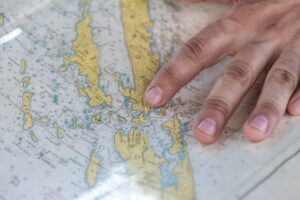
In general, sailboats can travel at speeds ranging from 4 to 8 knots, depending on the wind and sea conditions. However, some sailboats are capable of higher speeds, especially in racing conditions. The fastest sailboats in the world, such as hydrofoils and multihulls, can reach speeds of up to 50 knots.
The range of a sailboat varies widely depending on the size and type of the boat, as well as the conditions of the trip. A sailboat’s range can be increased by carrying extra fuel and water, using renewable energy sources such as solar panels and wind turbines, and conserving resources by minimizing power usage and reducing waste.
To maximize their daily distance, sailors must take into account the limits of their sailboat’s speed and range, as well as the changing conditions of wind and sea. This may involve adjusting their sail plan, navigating around obstacles such as land masses and shipping lanes, and planning their route to take advantage of favorable winds and currents.
Sailors can also use a variety of techniques to increase their speed and efficiency. These include adjusting the angle of the sails, trimming the sails to reduce drag, and using a spinnaker or other specialized sail to catch more wind. Additionally, sailors can use techniques such as heaving to and reefing the sails to maintain control in high winds or heavy seas.
In the next section, we will provide tips and insights for sailors who want to set out on their own adventure and explore the limits of their sailboat’s speed and range.
How many miles can a sailboat travel in a day?
Assuming a sailboat sails all 24 hours, the number of miles a sailboat can travel in a day can be calculated by multiplying its average cruising speed by 24. Racing sailboats average around 15 knots per hour. Cruising sailboats average 4-6 knots per hour.
Theoretically, in consistent and perfect conditions, a racing sailboat can travel 360 nautical miles in a day. Under the same theoretical conditions, a cruising sailboat can expect to travel between 96-144 nautical miles in a day.
A nautical mile is equal to 1.15 land miles. by So a racing sailboat can travel 414 “land” miles in a day. A cruising sailboat can travel 110-165 “land” miles per day.
Tips for Maximizing Your Daily Distance
Whether you are a seasoned sailor or just starting out, there are a few key tips that can help you maximize your sailboat’s daily distance.
-
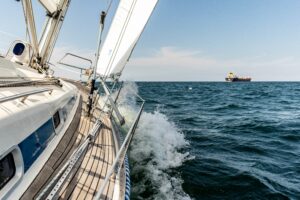
Adjusting your sail plan to navigate around obstacles such as shipping lanes can help to maximize your daily distance. Monitor wind and weather conditions: Keep an eye on the forecast and adjust your sail plan accordingly. Sails should be trimmed to catch the wind at the right angle, and reefed in strong winds to reduce the risk of capsizing or losing control. We recommend Predict Wind for wind and weather forecasting.
- Use navigation tools: Navigation tools such as GPS devices, charts, and compasses can help you plot your course and estimate your distance traveled. Keep track of your position and course to ensure that you stay on track and avoid hazards such as rocks, shoals, and shipping lanes.
- Optimize your sail plan: Experiment with different sail configurations to find the one that works best for your boat and the conditions. Use a spinnaker or other specialized sail to catch more wind when sailing downwind, and adjust the angle of the sails to maintain the right balance of speed and control.
- Practice good seamanship: Make sure your boat is well-maintained and equipped with the necessary safety gear, including life jackets, flares, and a first aid kit. Follow best practices for sailing, such as maintaining a lookout, avoiding collisions, and observing the rules of the road.
- Plan your route: Plan your route to take advantage of favorable winds and currents, and avoid obstacles such as land masses and shipping lanes. Keep in mind the range of your boat and plan for stops to refuel and restock on supplies.
By following these tips, you can maximize your sailboat’s daily distance and enjoy a safe and rewarding sailing adventure. Remember that sailing is both an art and a science and that there is always more to learn about the factors that influence a sailboat’s speed and range. With practice and experience, you can become a skilled and confident sailor and explore the seas with confidence.
Conclusion
In conclusion, the distance a sailboat can travel in a day depends on a variety of factors, including wind and sea conditions, the size and type of the boat, and the skills and experience of the crew. By understanding these factors and using the right techniques, sailors can maximize their daily distance and enjoy a safe and rewarding sailing adventure.
Whether you are a novice sailor or an experienced skipper, it is important to remember that sailing is a dynamic and constantly changing activity. Wind and sea conditions can vary from hour to hour, and sailors must be prepared to adjust their sail plan and navigate around obstacles as needed.
By following the tips and best practices outlined in this article, you can increase your sailboat’s speed and range, and explore the seas with confidence and skill. Remember to always prioritize safety, maintain your boat and equipment, and practice good seamanship at all times.
We hope that this article has provided you with valuable insights and inspiration for your next sailing adventure. Fair winds and following seas!
Learn more about the roots of sailing and view some of our sailing adventures at Outward Spaces.

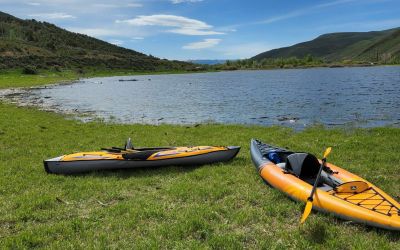

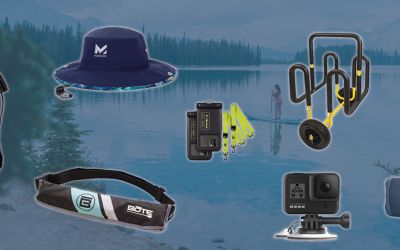
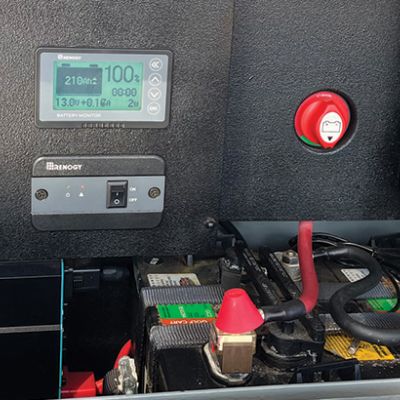

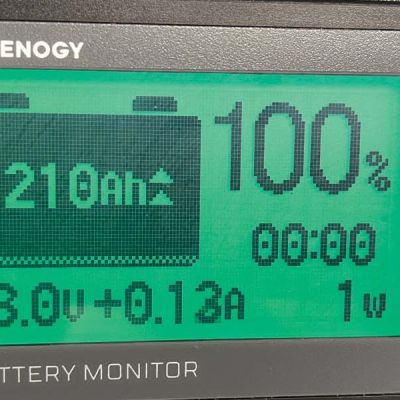

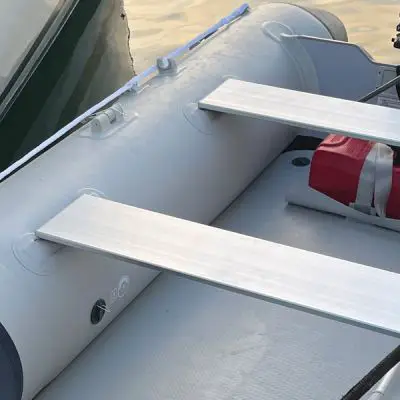
Leave a Reply